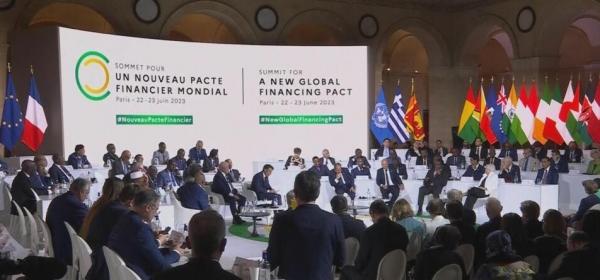Paris Climate Finance Pact Summit: no clear decisions but increased momentum
30 Jun 2023 by The Water Diplomat

France hosted an international summit on a new global financial pact on finance on the 22nd and 23rd of June. The summit aimed amongst others to create financial breathing space for countries facing financial difficulties, to promote private sector investment in low-income countries, to encourage investment in ‘green’ infrastructure, and to respond to the financial needs of countries vulnerable to climate change. The ambition as defined by French President Emmanuel Macron was to achieve a new consensus on the fight against poverty, the decarbonization of the economy and the protection of biodiversity. The financial aims were to clarify the amount of investment and the process required as well as to initiate a reform of global finance through the World Bank, the IMF, and public and private funds.
Despite its aims, the meeting ended without a major announcement from the 40 countries that were represented. Nevertheless, many issues were tabled, and progress was made on a number of topics. Much discussion has revolved around the pledge made at COP 15 in 2009 to make U.S. $ 100 billion in climate finance available per year by 2020. According to developed countries, the total amount currently available is U.S. $ 83 billion (some 30 billion through public bilateral channels, 40 billion through multilateral public channels, and the rest through mobilised private finance including export credits). The total amount committed therefore still falls short of the pledge made at COP 15. Climate activists have come forward to voice their criticism of both the amount and the means by which it is delivered: thus Harjeet Singh from the Climate Action Network, for instance, commented that too much reliance is being placed on the role of private sector investments and multilateral banks rather than on public sources of finance.
In Paris, the IMF managing director announced that it has reached the target of rechannelling U.S. $ 100 billion to poorer countries in the form of Special Drawing Rights (SDRs). To achieve this, a number of wealthier countries such as Japan and France have committed to pledge a portion of their own SDRs for use by low-income countries. However, there are still challenges in the delivery of this financial package. The first challenge is the lack of clear separation between finance that is strictly climate related and compensates poor countries for climate impacts largely created by industrialised countries, and finance that is ‘development’ related or designed to respond to global shocks such as the COVID-19 pandemic. The second is that this finance indeed largely comes in the form of loans and therefore threatens to increase overall indebtedness rather than providing debt relief.
A second major topic on which discussions advanced was around the climate-debt trap, whereby poor countries affected negatively by natural disasters need to take on new loans to respond to the damage. The World Bank Group announced a new toolkit for disaster preparedness which includes the possibility of pausing debt repayments and permitting the rapid redirection of a portion of funds for emergency needs if this is needed. This is to be backed up by improvements in early warning and emergency response systems.
A third proposal, tabled by French President Emmanuel Macron, was to impose taxation on shipping, aviation or financial transactions to help generate funds to respond to global problems. According to Macron, there has been political traction so far on constructing a tax on carbon emissions from shipping. It has been estimated that such a shipping tax, is instituted, could raise some U.S. $ 5 billion a year.
